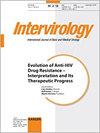猫杯状病毒主衣壳蛋白前体截短:与复制相关的产物,还是异常的翻译产物?
IF 1.8
4区 医学
Q3 VIROLOGY
引用次数: 0
摘要
本文章由计算机程序翻译,如有差异,请以英文原文为准。
Truncated Precursor of Feline calicivirus Major Capsid Protein: A Product Relevant for Replication, or an Aberrant Translation Artifact?
In a recent JVI paper by Urban and Luttermann [1], a truncated version of VP1 precursor (tLC-VP1) synthesized directly from the genomic RNA (gRNA) was detected for the first time for Feline calicivirus (FCV). Through a series of comprehensive reverse genetics experiments using 3DPol/LC-cleavage mutants, RIPA, luciferase reporter assays and deletion mutants, the authors demonstrated translational activity leading to tLC-VP1 synthesis starting at AUG codon 86, which they claim to be the second start codon within the whole LC-VP1 sequence. The authors suggested that a novel, scanning-independent, rather unknown translation initiation mechanism may be responsible for tLC-VP1 synthesis and identified specific sequences upstream of M86 that appear to be important for its efficiency. For example, in a reporter assay, the S3S mutant, lacking a stem-loop naturally occurring close to the LC-VP1 first AUG (M1), showed a dramatically decreased luciferase expression due to impaired translation initiation at M86. Furthermore, in a multiple-step growth assay, the S3S mutant showed decreased titers at early points of the curve, compared to wild-type FCV, though all assayed viruses reached similar end point titers. Based on these findings, the authors speculate that tLC-VP1 has a role during early phases of virus replication and claim that “all caliciviruses express VP1 from the gRNA” because it is essential and required early upon infection. We expected that the authors discussed the well-established fact that all caliciviruses encapsidate the subgenomic RNA (sgRNA) within the virions [2, 3], that is readily translated upon infection and the biological significance of producing a rather redundant tLC-VP1 in this context. The authors based their work on the sequence of FCV 2024 vaccine strain (GenBank AF479590.1) that contain no additional methionine residue between M1 and M86. However, a close look at other GenBank FCV sequences reveals that most FCV strains do possess another inframe AUG start codon within the LC-VP1 sequence at position 38 (M38), which has been overlooked in this work (Fig. 1a). In addition, when we compared the LCVP1 sequence from FCV strain Urbana with those of several members of the Vesivirus genus we found no inframe AUG start codon between the first ORF2 AUG (M1) and the putative proteolytic cleavage site responsible for LC excision and release of mature VP1, except for Allston calicivirus (M122, M134, M141) and SMSV-8
求助全文
通过发布文献求助,成功后即可免费获取论文全文。
去求助
来源期刊

Intervirology
医学-病毒学
CiteScore
5.40
自引率
0.00%
发文量
13
审稿时长
6-12 weeks
期刊介绍:
''Intervirology'' covers progress in both basic and clinical virus research, and aims to provide a forum for the various disciplines within virology. Issues publishing original papers alternate with thematic issues, focusing on clearly defined topics. This thematic concentration serves to make timely reviews, research reports and controversy easily accessible to both specialists in the field and those who want to keep track of the latest developments outside their own area of interest. In addition to original papers, regular issues publish short communications and letters to the editor to provide readers with a forum for the exchange of ideas and comments. The scope encompasses work on the molecular biology of human and animal viruses, including genome organization and regulation, and the structure and function of viral proteins. The pathogenesis, immunology, diagnosis, epidemiology, prophylaxis and therapy of viral diseases are considered.
 求助内容:
求助内容: 应助结果提醒方式:
应助结果提醒方式:


